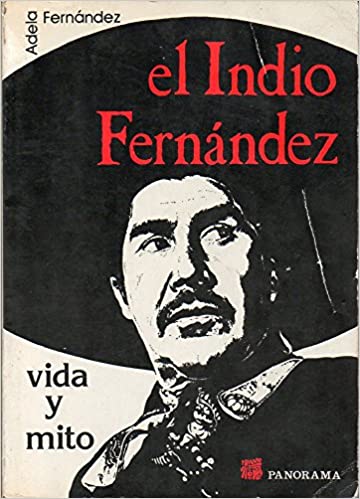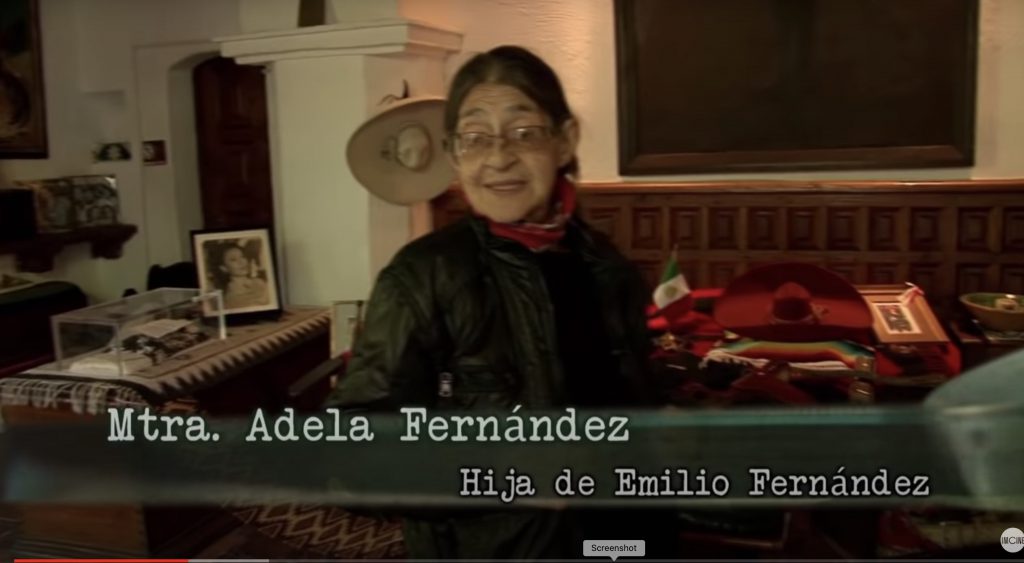I have re-read Adela Fernández’s memoir-biography* of her father, El Indio Fernández: vida y mito (1986) paying particular attention to mentions of María Félix, subject of my current project. Adela Fernández y Fernández (1942-2013) was an author, scriptwriter, and director who, at the time of writing her father’s biography was estranged from her father, Emilio ‘El Indio’ Fernández. Her funeral was celebrated in the house Emilio** had built, La Fortaleza [the fortress] in Coyoacan, Mexico City, and she was buried alongside him which suggests some form of reconciliation.
The book is a fascinating insight into a highly creative, troubled, and difficult individual at the centre of what was the peak of the Mexican film industry known as the Golden Age (1930s-1950s). Dolores Tierney (2007) has written an academic monograph about Emilio Fernández that is an invaluable insight into his films. Here, I want to give some sense of Adela’s text.

It is not a typical star biography, told as it is by a family member it slips into memoir for the most part with all the contingent loose attachment to subjectivity that label supposes. While Adela is estranged from her father, it is not a bitter book. But she can be critical, in particular of his attitude to women and his sometimes violent mood swings. Her account is of living with a man at the height of his creativity, who was highly social, and liked to hold court at home and host lavish parties. She drops the names of the many famous individuals who came to the house, but she is never starstruck.
Adela describes Emilio as someone who had conservative expectations about women’s behaviour and rigid ideas about their appearance and eating habits. He favoured women with long hair, who were thin, and conformed to specific ideas of femininity. In this vein, both María Félix and Dolores del Rio (Adela suggests that Emilio and del Rio had a relationship) conformed to his idea of the ideal women. Of course, Emilio did not invent these norms, but he did choose to impose them rigidly on “las muchachas” [the girls] who lived in his house (11). Full of contradictions, he expected purity from women, but was incapable of fidelity. Again, such double standards were not of his making. Aside from gossip about who some of these women were, Adela foregrounds the labour carried out by women to facilitate his lifestyle and the emotional toll of his behaviour on those around him.
Myth is in the title and Emilio’s self-mythologising and the myths told about him are addressed throughout, “Adjuntas a su fantasía personal, están las fantasías del pueblo” [alongside his personal fantasies, there are the public’s fantasies] (18). Describing him as a “monstruo sagrado” [sacred beast] (28), she unpacks these myths, but also presents his many charms. In bricolage style, the book is told in a mix of direct quotations from Emilio, Adela’s commentaries or framing of these, and her own reflections on what it meant to live in his household. Divided into eight chapters detailing key aspects of his life. The first chapter provides detail on his childhood and early career, sometimes countering at others validating some of the myths. The first chapter largely addresses a period before Adela’s birth and, therefore, would have required that she carry out research, later chapters draw on her life experiences. Chronologically told this chapter gives the effect of careful and authoritative biographical research, whereas later chapters are focused on other thematic or relational issues and are more subjectively told as is usual in a memoir and less attached to chronology.
Chapters two through eight address Emilio’s obsessions: his collection of animals of all sorts (dogs, snakes, chickens, horses, etc); the energy and money he put into his house (here she gives a guided tour of the house); his nationalism and scholarly engagement with indigenous traditions; his work rate and expectations of others; his capacity to drink and entertain; and his many affairs. In Adela’s version, he was a man of extremes, “El regalar una flor o el sorrajarle a alguien un golpe, en él son cosas de mera rutina” [he was as quick to gift someone a rose as to knock them sideways] (109).

The long lists of what he bought for the house or the detailed account of the animals he took in are less interesting than the insight Adela gives of what it meant to grow up amongst a creative milieu in mid-century Mexico with a powerful and volatile individual. Some of what she witnessed are the arbitrary decisions of a man who wielded his power over women’s careers when he felt that they did not live up to his standards or spurned his attentions. This is further evidence of how long such stories have been told and not taken seriously, that is, up to the recent shifts as a result of the MeToo movement. But, this is not purely a story of control, it is also an insight into moments of tenderness where Adela acknowledges her admiration for his many talents and provides glimpses of moments of domestic intimacy. For example, there is a section where she details the small private pleasures she shared with him that evoke the happy times they had (160).
There are accounts of his relationships with many collaborators, but for now I am interested in the María Félix. For Adela, Emilio and Félix had a unique relationship. Adela describes Félix as having a reputation for being “una mujer difícil de satisfacer” [hard to satisfy] (180), who, nonetheless, had an excellent working relationship with Emilio. She describes them as working as equals, “Las relaciones de trabajo entre ellos han sido de las mejores que han habido en el cine mexicano: respeto, ductilidad, predisposición en rendirse homenaje uno a otro, empeño por imprimir lo mejor de ellos mismos en una obra de arte” [their working relationship was the best there ever was in Mexican film. There was respect, flexibility, a predisposition to pay tribute to one another, and determination to put their best work into each film] (182). Adela does not think they ever had a romantic relationship, but Emilio was enamoured with Félix’s walk and the way she moved (183). She credits Félix with Emilio’s return to acting. She used her influence in to have him case in La Cucaracha (Ismael Rodríguez, 1958) which led to numerous subsequent roles (221-222).
The above quotation also gives a sense of the occasional slips into hyperbole in the memoir-biography, and conveys the admiration Adela had for her father’s artistic output. As star biography and as memoir, this book merits a close reading. It is an intelligent and emotionally complex account of what it means to grow up at the edges of fame. It also gives a fuller sense of Emilio, myths and all.
*There are slippages between these two types of writing in the text, which make it difficult to fully ascribe a single label. Paul de Man (1979) has written about life writing (specifically autobiography) as a reading position, which could be a useful way to think about this text.
**Because both are Fernández, I will use their given names to avoid confusion. Tierney discusses the gnarly issue of the nickname “El Indio” in her work. I will avoid using it for some of the reasons she details although it is the name Adela uses throughout her book.
Selected reading
De Man, Paul (1979) “Autobiography as De-facement.” MLN 94, no. 5: 919-30. Accessed May 1, 2020. doi:10.2307/2906560.
Fernández, Adela (1986) El Indio Fernández: vida y mito Mexico City: Panorama Editorial.
Tierney, Dolores (2007) Emilio Fernández: Pictures in the Margins Manchester & New York: Manchester University Press.